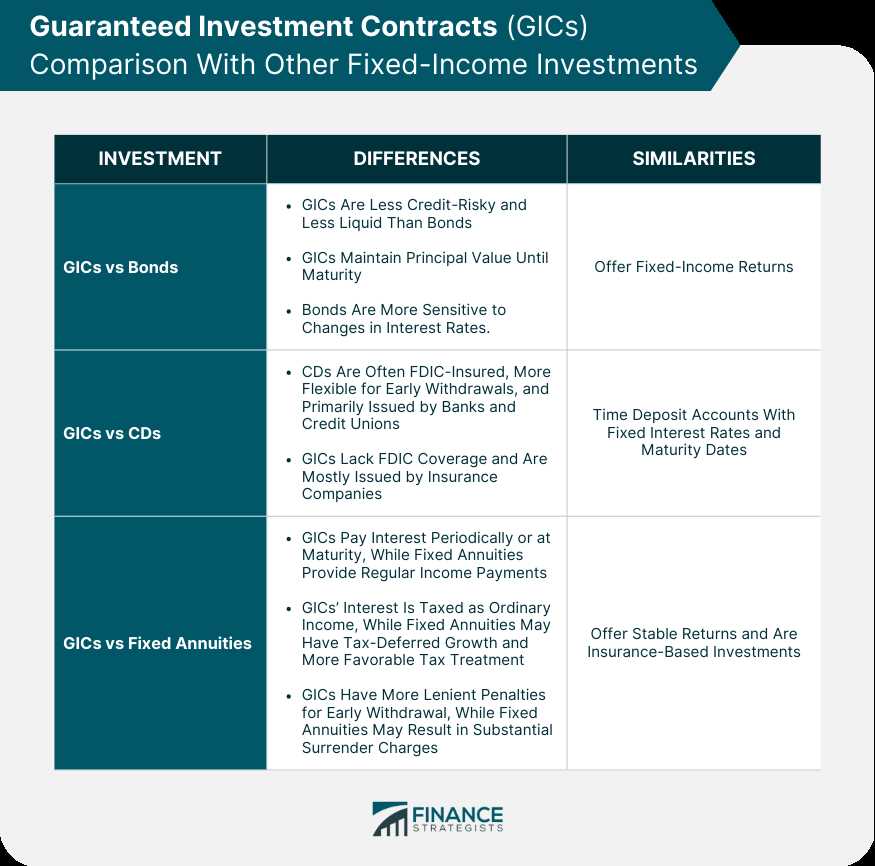What is a Guaranteed Investment Contract?
A Guaranteed Investment Contract (GIC) is a type of investment vehicle that is offered by insurance companies and other financial institutions. It is a fixed-term investment that provides a guaranteed rate of return over a specified period of time.
How does a GIC work?
When you invest in a GIC, you are essentially lending money to the issuer (usually an insurance company) for a fixed period of time. In return, the issuer guarantees to repay your principal investment along with a fixed rate of interest at the end of the term.
Features of a GIC
There are several key features of a GIC that make it an appealing investment option:
- Guaranteed return: The principal investment and the interest earned are guaranteed by the issuer, providing investors with a sense of security.
- Fixed term: GICs have a predetermined term, which means that your money is locked in for a specific period of time. This can be advantageous for investors who want to save for a specific goal or have a predictable income stream.
- Flexible interest payment options: GICs offer different options for receiving interest payments, such as monthly, quarterly, or annually. This allows investors to choose a payment schedule that aligns with their financial needs.
- Insurance protection: GICs offered by insurance companies are often backed by the insurer’s financial strength and stability, providing an additional layer of protection for investors.
Considerations when investing in a GIC
While GICs offer a secure and reliable investment option, there are a few considerations to keep in mind:
- Fixed returns: GICs offer a fixed rate of return, which means that you will not benefit from any potential increases in interest rates during the term of the investment.
- Inflation risk: GICs may not provide a return that keeps pace with inflation, which means that the purchasing power of your investment may decrease over time.
Conclusion
How do GICs work?
At the end of the term, you will receive your initial investment amount, along with the accumulated interest. The interest can be paid out to you periodically (monthly, quarterly, annually) or reinvested back into the GIC to compound your earnings.
Types of GICs
There are different types of GICs available, each with its own set of features and benefits. Some common types include:
- Fixed-rate GICs: These GICs offer a fixed rate of interest for the entire term.
- Variable-rate GICs: These GICs offer a variable rate of interest that can fluctuate based on market conditions.
- Callable GICs: These GICs can be redeemed by the issuer before the end of the term, which may be beneficial if interest rates rise.
Benefits of investing in GICs
GICs offer several benefits that make them an attractive investment option:
- Stability: The fixed rate of return offered by GICs provides stability and predictability in an investment portfolio.
- Diversification: GICs can be used to diversify an investment portfolio by adding a low-risk component.
- Tax advantages: GICs held within a registered account, such as a Tax-Free Savings Account (TFSA) or Registered Retirement Savings Plan (RRSP), can provide tax advantages.
Benefits of Investing in GICs
Investing in Guaranteed Investment Contracts (GICs) can provide numerous benefits for investors. Here are some key advantages of including GICs in your investment portfolio:
1. Safety and Security
GICs are considered to be one of the safest investment options available. They are typically issued by highly reputable financial institutions, such as banks or insurance companies, which ensures the safety of your principal investment. Unlike stocks or other volatile investments, GICs offer a guaranteed return of your initial investment.
2. Stable and Predictable Returns

GICs provide investors with stable and predictable returns. The interest rate on a GIC is fixed for a specific period of time, often ranging from a few months to several years. This allows investors to accurately forecast their returns and plan their finances accordingly.
3. Diversification
GICs offer a way to diversify your investment portfolio. By including GICs along with other investment options, such as stocks and bonds, you can spread your risk and reduce the impact of market fluctuations. GICs provide a stable and secure foundation for your portfolio, complementing the potentially higher returns of other investments.
4. Flexibility
GICs offer flexibility in terms of investment duration and payout options. You can choose the length of the GIC term that suits your investment goals, ranging from short-term to long-term options. Additionally, GICs can provide various payout options, such as monthly, quarterly, or annual interest payments, allowing you to customize your investment strategy based on your financial needs.
5. Tax Advantages

GICs can offer tax advantages depending on the type of account in which they are held. For example, if you hold a GIC in a tax-deferred account like an Individual Retirement Account (IRA), you can defer taxes on the interest earned until you withdraw the funds. This can help maximize your investment returns and potentially reduce your tax liability.
Why GICs are a Secure and Reliable Investment Option
Guaranteed Investment Contracts (GICs) are considered to be a secure and reliable investment option for several reasons:
- Principal Protection: One of the main advantages of GICs is that they offer principal protection. This means that the initial investment amount is guaranteed and will not decrease, regardless of market fluctuations. This makes GICs an attractive option for conservative investors who prioritize the safety of their capital.
- Stable Returns: GICs provide investors with a fixed rate of return over a specified period of time. This fixed interest rate ensures that investors know exactly how much they will earn on their investment. The predictable and stable returns make GICs a popular choice for individuals who prefer a steady income stream.
- Low Risk: GICs are considered to be low-risk investments because they are typically issued by reputable financial institutions such as banks or insurance companies. These institutions have a strong track record and are regulated by governing bodies, which adds an extra layer of security for investors.
- Flexible Terms: GICs offer investors the flexibility to choose the term length that suits their investment goals. Terms can range from a few months to several years, allowing investors to align their GICs with their financial objectives and time horizons.
- Insurance Coverage: In many countries, GICs are covered by deposit insurance programs, which protect investors in the event of a financial institution’s failure. This insurance coverage provides an additional level of security and peace of mind for GIC investors.
How to Utilize GICs in Your Investment Strategy
Guaranteed Investment Contracts (GICs) are a valuable tool that can be utilized in your investment strategy to achieve financial goals and secure your future. Here are some key steps to effectively incorporate GICs into your investment plan:
1. Assess Your Investment Goals
Before incorporating GICs into your investment strategy, it is important to assess your investment goals. Determine what you hope to achieve with your investments, whether it is long-term growth, capital preservation, or a combination of both. This will help you determine how much of your portfolio should be allocated to GICs.
2. Understand the Risks and Rewards

While GICs offer a high level of security and guaranteed returns, it is important to understand the risks and rewards associated with these investments. GICs typically offer lower returns compared to other investment options such as stocks or mutual funds. However, they provide a stable and predictable source of income, making them an attractive option for conservative investors.
3. Diversify Your Portfolio
When incorporating GICs into your investment strategy, it is important to maintain a diversified portfolio. This means allocating your investments across different asset classes and investment vehicles. By diversifying, you can reduce the overall risk of your portfolio and potentially increase your returns.
4. Choose the Right GICs
5. Consider Laddering Your GICs

Laddering is a strategy that involves investing in GICs with different maturity dates. This allows you to take advantage of higher interest rates offered by longer-term GICs while still maintaining access to a portion of your investment in the short term. By laddering your GICs, you can maximize your returns and maintain liquidity.
6. Review and Adjust Regularly
Once you have incorporated GICs into your investment strategy, it is important to regularly review and adjust your portfolio. Keep track of the performance of your GICs and make any necessary changes based on market conditions and your changing investment goals. Regularly reviewing and adjusting your portfolio will help ensure that your investment strategy remains aligned with your financial objectives.
Incorporating GICs into your investment strategy can provide stability, security, and guaranteed returns. By following these steps and carefully considering your investment goals and risk tolerance, you can effectively utilize GICs to enhance your investment portfolio and achieve your financial objectives.

Emily Bibb simplifies finance through bestselling books and articles, bridging complex concepts for everyday understanding. Engaging audiences via social media, she shares insights for financial success. Active in seminars and philanthropy, Bibb aims to create a more financially informed society, driven by her passion for empowering others.
